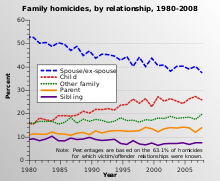Familicide
| Part of a series on |
| Homicide |
|---|
| Murder |
|
Note: Varies by jurisdiction
|
| Manslaughter |
| Non-criminal homicide |
|
Note: Varies by jurisdiction |
| By victim or victims |
| Family |
| Other |
| Suicide |
|---|
 |
|
Related phenomena |
A familicide is a type of murder or murder-suicide in which a perpetrator kills multiple close family members in quick succession, most often children, spouse, siblings, or parents.[1][2] In half the cases, the killer then kills themselves in a murder-suicide.[3][4][5] If only the parents are killed, the case may also be referred to as a parricide. Where all members of a family are killed, the crime may be referred to as family annihilation.
Familicide of others
Familicides were used as an enhanced punishment in antiquity. In ancient China, the "nine familial exterminations" was the killing of an entire extended family or clan, usually for treason. Machiavelli advocated the extermination of a previous ruler's family to prevent uprisings in The Prince.[6] Sippenhaft was used in Nazi Germany to punish and sometimes execute the relatives of defectors and anyone involved in the 20 July plot.[7] La Cosa Nostra began killing the relatives, including women and more recently children, of informants (pentiti) and rivals in the 1980s.[8][9] It is not incorporated formally into any modern judicial systems, except in North Korea, where whole-family internment at Kaechon internment camp often ends in death.[10]
Family annihilation
Definition and statistics
Of 909 victims of mass murder (defined as 4 victims within a 24-hour period) in the US from 1900 to 2000, more than half occurred within an immediate family. Although the total number of familicide cases are relatively rare, they are the most common form of mass killings. However, statistical data is difficult to establish due to reporting discrepancies.[11]
Familicide differs from other forms of mass murder in that the murderer kills family members or loved ones rather than anonymous people. This has a different psychodynamic and psychiatric significance, but the distinction is not always made.[12]
A study of 30 cases in Ohio found that most of the killings were motivated by a parent's desire to stop their children's suffering.[11]
In Australia, a study was done of seven cases of filicide followed by suicide in which marital separation followed by custody and access disputes were identified as an issue. Some common factors such as marital discord, unhappiness, domestic violence, sexual abuse, threats of harm to self or others were found in varying degrees. It was not clear what could be done in terms of prevention.[13]
Narrative
The internal logic for family annihilation can stem from a number of sources.
David Wilson of Birmingham City University has divided these cases into four groups: anomic, disappointed, self-righteous and paranoid.
In this typology, the anomic killer sees his family purely as a status symbol; when his economic status collapses, he sees them as surplus to requirements. The disappointed killer seeks to punish the family for not living up to his ideals of family life. The self-righteous killer destroys the family to exact revenge upon the mother, in an act that he blames on her. Finally, the paranoid killer kills their family in what they imagine to be an attempt to protect them from something even worse.[14]
Notable familicides
- Osmington shooting, May 11, 2018, Osmington, Western Australia; seven members of the Miles family (two grandparents, the mother, and four children) were shot dead - police are treating it as a murder-suicide
- Earl Valentine, September 6, 2016, Norlina, North Carolina, killed his son and critically injured his ex-wife. Killed himself when his motel room was surrounded by law enforcement.
- Cairns child killings, December 18–19, 2014, Cairns, Australia; eight children (seven siblings and one cousin) were drugged and then stabbed to death by the mother - she was found not guilty by reason of insanity
- Joshua Powell February 5, 2012, Suspect in his wife, Susan Powell's disappearance, killed his two younger sons and then himself.
- Neal Jacobson, January 26, 2010, Wellington, Florida, killed his wife, Franki, and twin sons, age 7.
- William Parente, April 19–20, 2009, killed his wife, two daughters, and himself.
- Steven Sueppel, March 23 or March 24, 2008, killed his wife, four children, and himself.
- Chris Benoit, June 22–24, 2007, killed his wife, son, and himself.
- Neil Entwistle, January 20, 2006, killed his wife and infant daughter
- Marcus Delon Wesson, March 12, 2004, killed nine of his children/wives that he fathered through his legal wife and his polygamist wives who were also his daughters and nieces.
- Scott Peterson, December 24, 2002, killed his wife Laci, who was eight months pregnant at the time of her death
- Dipendra Bir Bikram Shah, June 1, 2001, allegedly killed the royal family of Nepal at a family dinner and died from a self-inflicted gunshot to the head.
- Robert William Fisher, April 10, 2001, wanted for murder of his wife and their two children in Scottsdale, Arizona; has been charged with three counts of first-degree murder and one count of arson of an occupied structure; currently on the FBI Ten Most Wanted Fugitives list.
- Phillip Austin, July 10, 2000, murdered his wife, two children, and the family's two dogs in a series of violent attacks.
- Kip Kinkel, May 20, 1998, killed his parents before committing a school shooting, leaving two additional dead and 25 wounded.
- Charles Stuart, October 23, 1989, killed pregnant wife and blamed it on imaginary black hijacker; seven-month-old fetus delivered alive but died in 17 days; committed suicide less than three months after murders.
- Ronald Gene Simmons, from December 22, 1987, to December 28, 1987, killed 14 family members ranging in age from 20 months to 46. Eight of the 14 were all children whose ages were 20 months, 1, 3, 6, 8, 11, 14, and 17. Mr. Simmons killed 14 of his family members as they arrived for their family Christmas gathering from December 22 to December 26 (7 family members were killed as they arrived on December 22 and another 7 were killed as they arrived on December 26). Two days later, Mr. Simmons then proceeded into his local town where he killed 2 more victims at several local businesses on December 28, 1987, bringing his total number of victims he fatally wounded to 16. He also injured 4 additional victims, who all survived, at the local businesses he targeted.
- Bradford Bishop, 1976, killed his three children, mother, and his wife.
- James Ruppert, March 30, 1975, Easter Sunday, killed 11 family members in his mother's house in Hamilton, Ohio.
- Ronald DeFeo, Jr., November 13, 1974, killed his father, mother, two brothers, and two sisters.
- John List, November 9, 1971, killed his wife, mother, and three children in their home in Westfield, New Jersey, and then disappeared. A fugitive from justice for nearly 18 years, List was finally apprehended on June 1, 1989, after the story of his murders was broadcast on the television program America's Most Wanted.
- Jeffrey MacDonald, February 17, 1970, convicted of killing his wife and two preschool daughters.
- Charles Whitman, August 1, 1966, killed his wife and mother before committing the University of Texas at Austin campus spree shooting, killing 16 people and wounding 32 others. He was shot and killed by Austin police officer Houston McCoy.
- Magda Goebbels and her husband Joseph, Minister of Propaganda of Nazi Germany and briefly Chancellor of Germany, on May 1, 1945, fatally poisoned their six children before committing suicide together. Harald Quandt, Magda's son from a previous marriage, was the only member of the family to survive.
- Marty Bergen, January 19, 1900, killed his wife and children with an ax, then slit his own throat.
- George Forster, allegedly killed his wife and child by drowning them in Paddington Canal, London; later hanged at Newgate on 18 January 1803.
- Van Breda murders
- Death of the Watts family
Artistic depiction
Family annihilation is depicted in the following media:
- Natural Enemies
- Beloved
- Downfall
- The Others
- The Seventh Continent
- Someone Behind You
- Halloween
- Sinister
- Amityville II: The Possession
- Puella Magi Madoka Magica
- Torchwood: Children of Earth
- The Fourth Kind
- Logan
- Utopia
- P.T. (video game)
- Critical Role (D&D, stream, Season 2 Episode 18 : Whispers of War)
- Girls & Boys, a one-woman play by Dennis Kelly which premiered at the Royal Court in 2018.
Related terms

- Filicide – the killing of a child (or children) by one's own parent (or parents)
- Infanticide – the killing of one's child (or children) up to 12 months of age
- Mariticide – the killing of a husband by a wife, but commonly used for either spouse
- Matricide – the killing of one's mother
- Patricide – the killing of one's father
- Uxoricide – the killing of a wife by a husband
References
- ↑ Liem, Marieke; Levin, Jack; Holland, Curtis; Fox, James A. (1 May 2013). "The Nature and Prevalence of Familicide in the United States, 2000–2009". Journal of Family Violence. 28 (4): 351–358. doi:10.1007/s10896-013-9504-2. ISSN 0885-7482.
- ↑ Websdale, Neil (2008). "Familicide". Encyclopedia of Interpersonal Violence. SAGE Publications, Inc.: 238–238. doi:10.4135/9781412963923.n161.
- ↑ Wilson, Margo; Daly, Martin; Daniele, Antonletta (1995). "Familicide: The Killing of Spouse and Children" (PDF). Aggressive Behavior. 21: 275–291. doi:10.1002/1098-2337(1995)21:4<275::aid-ab2480210404>3.0.co;2-s. Archived from the original (PDF) on 2007-09-26.
- ↑ Scheinin, Lisa; Rogers, Christopher B.; Sathyavagiswaran, Lakshmanan. "Familicide—Suicide". The American Journal of Forensic Medicine and Pathology. 32 (4): 327–330. doi:10.1097/paf.0b013e31821a555a.
- ↑ Sachmann, Mark; Harris Johnson, Carolyn Mary (1 March 2014). "The Relevance of Long-Term Antecedents in Assessing the Risk of Familicide-Suicide Following Separation". Child Abuse Review. 23 (2): 130–141. doi:10.1002/car.2317. ISSN 1099-0852.
- ↑ Machiavelli, Niccolò (1532). The Prince. chap. 4. Retrieved 2017-04-26.
- ↑ Loeffel, Robert (February 2007). "Sippenhaft, Terror and Fear in Nazi Germany: Examining One Facet of Terror in the Aftermath of the Plot of 20 July 1944" (PDF). Contemporary European History. Cambridge University Press. 16 (1): 51–69. doi:10.1017/S0960777306003626. Retrieved 2017-04-27.
- ↑ Bohlen, Celestine (October 11, 1995). "As Code of Silence Cracks, Mafia Changes Rules". The New York Times. Retrieved 2017-04-27.
- ↑ Parry, Tom (April 12, 2014). "Children murdered by the Mafia as Italian mobsters sink to new low". Mirror Online. Retrieved 2017-04-27.
- ↑ "Prison Camps of North Korea - Camp 14 Kaechon". HumanRights.gov. Retrieved 2017-04-27.
- 1 2 Berton, Justin. Familicide: Experts say family murder-suicides, though rare, are most common mass killing. San Francisco Examiner, June 20, 2007
- ↑ Malmquist, Carl P., MD. Homicide: A Psychiatric Perspective. Arlington, VA: American Psychiatric Publishing, 1996, ISBN 978-0-88048-690-3
- ↑ Johnson, Carolyn. Familicide and Custody Disputes - Dispelling The Myths. University of Western Australia, FamilicideAbstract_CarolynJohnson.pdf
- ↑ Melissa Hogenboom (15 August 2013). "Criminologists identify family killer characteristics". BBC News.
- ↑ Cooper, Alexia D.; Smith, Erica L. (2011-11-16). Homicide Trends in the United States, 1980-2008 (Report). Bureau of Justice Statistics. p. 11. NCJ 236018. Archived from the original on 2018-03-30.
- http://www.bbc.co.uk/news/uk-17097802
- http://www.standard.co.uk/news/crime/tragic-cases-of-family-annihilation-in-the-uk-8079274.html
- http://www.dailymail.co.uk/home/you/article-1247997/What-drives-father-destroy-family.html
- http://www.telegraph.co.uk/news/8961851/What-drives-a-father-to-kill.html
- http://www.counterfire.org/index.php/articles/opinion/6148-family-annihilation-debt-depression-and-the-fragile-family
External links
| Look up familicide in Wiktionary, the free dictionary. |
- Skipp, Catharine (Feb 11, 2010). "Inside the Minds of Family Annihilators". Newsweek.